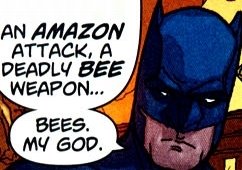Trojita
Rapid Response Threadmaker
http://news.yahoo.com/zombie-fly-parasite-killing-honeybees-230200867.html

Yeah, I kind of found most of it worth bolding.

A heap of dead bees was supposed to become food for a newly captured praying mantis. Instead, the pile ended up revealing a previously unrecognized suspect in colony collapse disorder a mysterious condition that for several years has been causing declines in U.S. honeybee populations, which are needed to pollinate many important crops. This new potential culprit is a bizarre and potentially devastating parasitic fly that has been taking over the bodies of honeybees (Apis mellifera) in Northern California.
John Hafernik, a biology professor at San Francisco State University, had collected some belly-up bees from the ground underneath lights around the University’s biology building. “But being an absent-minded professor,” he noted in a prepared statement, “I left them in a vial on my desk and forgot about them.” He soon got a shock. “The next time I looked at the vial, there were all these fly pupae surrounding the bees,” he said. A fly (Apocephalus borealis) had inserted its eggs into the bees, using their bodies as a home for its developing larvae. And the invaders had somehow led the bees from their hives to their deaths. A detailed description of the newly documented relationship was published online Tuesday in PLoS ONE.
The team performed a genetic analysis of the fly and found that it is the same species that has previously been documented to parasitizie bumblebee as well as paper wasp populations. That this parasite hasn’t previously been reported as a honeybee killer came as a surprise, given that “honeybees are among the best-studied insects of the world,” Hafernik said. “We would expect that if this has been a long-term parasite of honeybees, we would have noticed.”
The team found evidence of the fly in 77 percent of the hives they sampled in the Bay Area of California, as well as in some hives in the state’s agricultural Central Valley and in South Dakota. Previous research has found evidence that mites, a virus, a fungus, or a combination of these factors might be responsible for the widespread colony collapse. (Read more about colony collapse disorder in our feature “Solving the Mystery of the Vanishing Bees.”And with the discovery that this parasitic fly has been quietly killing bees in at least three areas, it might join the list of possible forces behind colony collapse disorder.
Parasitic fly larva emerging from a dead bee's neck. Courtesy of John Hafernik
The parasitic fly lays eggs in a bee’s abdomen. Several days later, the parasitized bee bumbles out of the hives often at night on a solo mission to nowhere. These bees often fly toward light and wind up unable to control their own bodies. After a bee dies, as many as 13 fly larvae crawl out from the bee’s neck. The bees’ behavior seems similar to that of ants that are parasitized and then decapitated from within by other fly larvae from the Apocephalus genus.
“When we observed the bees for some time the ones that were alive we found that they walked in circles, often with no sense of direction,” Andrew Core, a graduate student who works with Hafernik and a co-author on the new paper, said in a prepared statement, describing them as behaving “something like a zombie.” (Read about other parasites that turn their hosts into zombies in the article “Zombie Creatures.”
Bees from affected hives and the parasitizing flies and their larvae curiously also contained genetic traces of Nosema ceranae, another parasite, as well as a virus that leads to deformed wings which had already been implicated in colony collapse disorder. This double infection suggests that the flies might even be spreading these additional hive-weakening factors.
Yeah, I kind of found most of it worth bolding.





